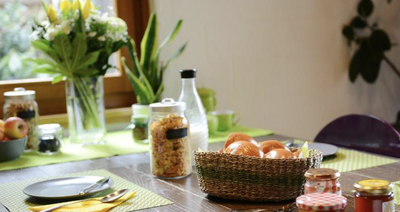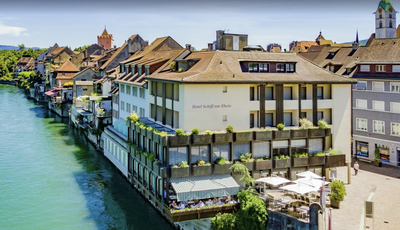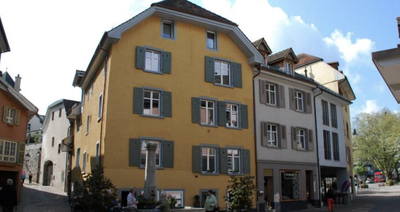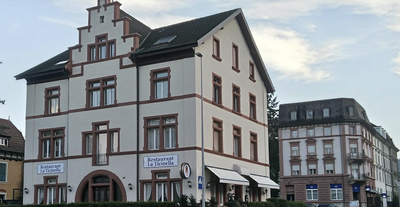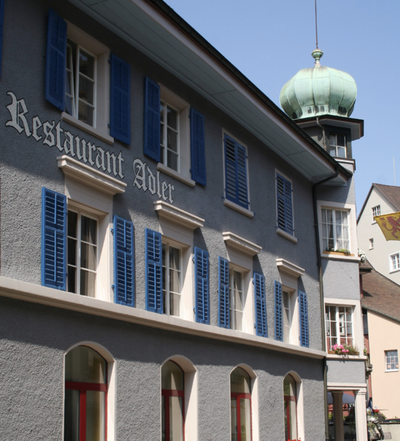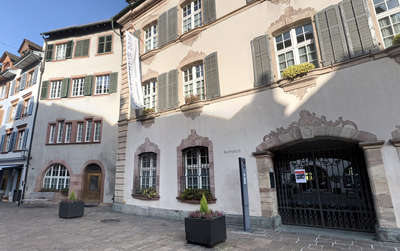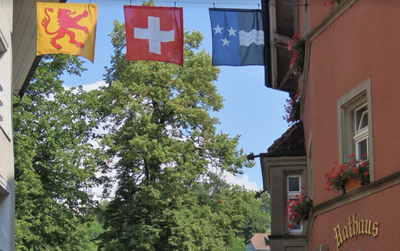
2. Rheinfelden to Laufenburg
10 points of interest

Tour de sel TouristSalt Drilling Towers
Until 1844, Switzerland was obliged to import salt. The discovery of salt deposits on the banks of the Rhine in particular made it self-sufficient. The oldest of the salt works was closed down in 1942. The wooden towers are the remnants.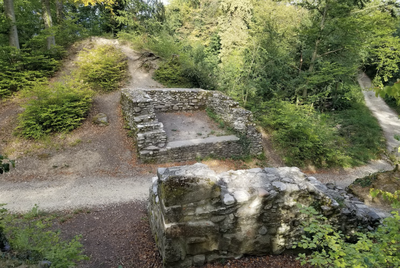
Tours romaines HistoricalRoman Towers
The path passes between the foundations of two square Roman towers that marked the entrance to a fortified camp.
Château de Schwörstadt HistoricalSchwörstadt Castle
Prominent on the other side of the Rhine in Germany is Schwörstadt Castle, whose remains date back to 1280, one of the many castles that controlled the Rhine. The new building dates from 1834.

Église St Martin CulturalSaint Martin's Church
Although the church was first mentioned in documents in 1302, various archaeological investigations and cross-comparisons indicate that it was built in the 10th century as the church of the monastery of Säckingen. The choir was demolished in 1956/57 and replaced by a new building about three times larger than the original one.
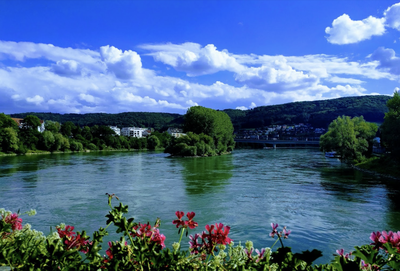
Saint Fridolin CulturalSaint Fridolin
Saint Fridolin is an Irish monk, "apostle of Alemania". Abbot to Saint Hilary in Poitiers, he founded an abbey in Bad Säckingen and died around 540, the time when Saint Colomban was born in Ireland.

Gallusturm St ColumbanGall Tower
The Gallusturm was built in 1343 as a breakwater after a flood that hit the island town at the time because the Rhine branched off into a main branch and a branch to the north that surrounded the town.
St. Fridolinmünster CulturalSt Fridolin Cathedral
The monastery church was built in the Romanesque style, rebuilt in the Gothic style after a fire in the 14th century and renewed in the 17th and 18th centuries with elements of Baroque style. The remains of St. Fridolin are now preserved in the Fridolin Chapel on the right side of the choir in a richly decorated silver sanctuary.

Château HistoricalCastle
The remains of the castle occupy a rocky promontory that juts out into the Rhine and forces it to sink into a deep, narrow bed. The Rhine rapids are the origin of the name of the town at the foot of the castle, which dates back to the 15th century.
Sankt Johann Kirche CulturalSt. John's Church
The present church was built between 1439 and 1510.
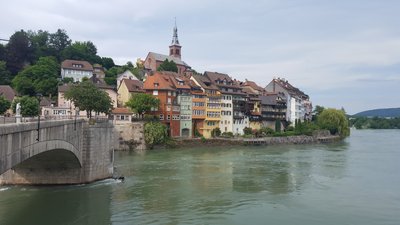
Point de vue PanoramicPanoramic viewpoint
The bridge over the Rhine rapids between two rocky promontories gives an unobstructed view of the two towns of the same name.
Description
Leaving the church on the right, cross the square diagonally to reach Untere Kirchstrasse and then in the axis the Fluhgässli passage before turning left (Brodlaube). When you reach Kupfergasse, turn right and cross the city walls under the Storchennesturm tower and cross the Magdener stream:
- In front of the city park, turn left to join the Rhine and track 60 Via Rhenana. Two hydroelectric power plants delimit a loop of the Rhine and a forest path on this bank and crops on the other bank facing south.
- The next two loops of the river as well as two watchtowers from the Roman period delimit a natural forest reserve while on the other side the German city of Schwörstadt is clearly visible with its castle.
- The forest stops to give way to agricultural areas between small towns like Wallbach and Mumpf where the 10th century St Martin's church is worth a visit.
- In the next village (Stein), it is possible to continue on the Swiss shore or visit the German town of Bad Säckingen (recommended) by taking the first bridge from Rheinfelden, Fridolinsbrücke, with the statue of the Irish saint present here in the 6th century. At the end of the bridge, turn right to reach the edge of the Rhine, pass in front of the St Peter und Paul chapel and enter the park of Schönau Castle. Cross it diagonally and, at the exit, turn left onto Schönaugasse and then right onto Wernergasse to reach Münsterplatz and visit St Fridolin Basilica. The return to Switzerland is via a historic and magnificent bridge, the Rheinbrücke, the longest covered wooden bridge in Europe.
- The next Swiss village (Sisseln) again marks the entrance to a forest area before reaching Laufenburg. Advance through the city by staying on the banks of the Rhine to the end of a picnic area. Turn right, cross the Untere Wassengasse and take the opposite Herrengasse to reach the church.
- Departure : Church St Martin, Kircheplatz, 4310 Rheinfelden
- Arrival : Church Sankt Johann, Schlossbergsteig 197, 5080 Laufenburg
- Towns crossed : Aargau and Baden-Württemberg
Altimetric profile
Report a problem or an error
If you have found an error on this page or if you have noticed any problems during your hike, please report them to us here:

